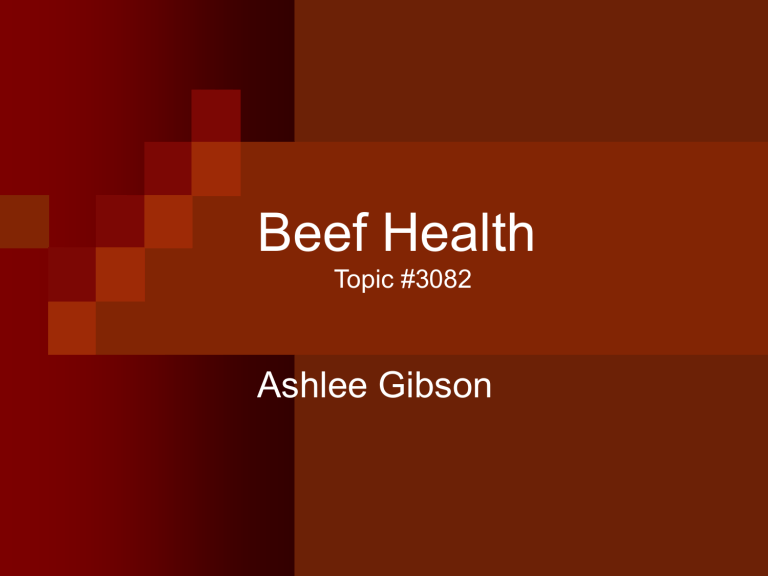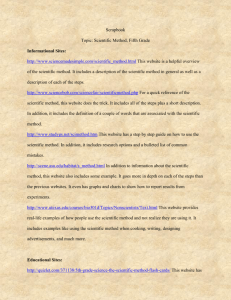Beef Health
advertisement

Beef Health Topic #3082 Ashlee Gibson Objectives To identify general health symptoms To understand causes, signs, prevention, and control of different diseases To know ways and location to administer medicine General Health Information Body Temperature Range of 100.5 F to 103 F (101.5 F) Taken rectally General Health Information Respiration Rate of breathing 10 to 30 breaths per minute General Health Information Heart Rate (Pulse) Regular throbbing caused in the arteries by the contractions of the heart. When taking a pulse, count for 15 seconds and then multiply by four to get a full minute reading. 40 to 70 beats per minute General Signs of Illness Head down Not alert In the corner Will not stand up Coughing Nasal or eye discharge Diarrhea Heavy Breathing Rough coat Change in body temperature http://www.ars.usda.gov/is/graphics/photos/jul00/k8930-2i.jpg Respiratory Diseases “Shipping Fever” Cause: Viral or bacterial Sign: high fever, coughing, weight loss, diarrhea, nasal and eye discharge, could cause abortion Prevention: Vaccination Control: Antibiotics Example: IBR, BVD, BRSV, Pasteurella Clostridial Diseases Blackleg & Malignant Edema Cause: Organisms in soil that enter through mouth or open sore Signs: Swelling over heavy muscle areas. Gas bubbles and fluid beneath skin Prevention: Vaccination Treatment: Penicillin Digestive Diseases Caused from incorrect feeding or rations Bloat Flounder Digestive Disease Bloat: Gas build up in rumen Cause: Rich feeds Sign: Bulge towards last rib and hip Treatment: Take away feed, movement, in severe cases stomach tube or puncture is needed Digestive Disease http://agnews.tamu.edu/dailynews/stories/ANSC/photos/Mar1605a-lr.jpg Digestive Diseases Flounder- inflammation of hoof wall Cause: high concentration of feed Sign: limping Treatment: Could lead to lameness External Parasites Flies, Lice, Mites, and Grubs Annoy and irritate and transmit disease Sign: Visible, rubbing, hair loss Control: Face oilers dust bags, ear tags with insecticides, spraying or dipping cattle with insecticides http://www.jefferslivestock.com/ssc/assets/product_images/Livestock/CattleRubPW.C1.jpg Internal Parasites Roundworms, Tape worms, and Flukes Attach to wall of digestive tract Signs: Poor weight gain, rough hair coat, diarrhea or constipation Prevention and Treatment: Dewormer http://www.valleyvet.com/ct_search_results.html?start=81 Other Common Diseases Foot rot Cause: Bacteria enters through cut in hoof Sign: Limping Prevention: Keep pasture of feedlot clear of sharp objects and dry pen Treatment: Antibiotics and/or foot wrap Other Common Diseases Warts Cause: Virus Sign: Growth that looks like a cauliflower Prevention: Isolation of infected animals Treatment: Vaccines or manually remove http://www2.dpi.qld.gov.au/images/2757.jpg Other Common Diseases Ringworm Cause: Fungus Sign: Loss of hair Prevention: Isolate and keep pen dry Treatment: fungicides or sunlight http://www.vetmed.wisc.edu/pbs/zoonoses/Systemic%20mycoses/ringwormcow.html Other Common Diseases Pink eye Cause: eye infected by bacteria Sign: eye discharge, white dot in middle of eye Prevention: Fly control, keep pen clean Treatment: Keep in cool, darkened pen, apply antibiotic ointments Pink Eye http://www.flycontrol.novartis.com/includes/teasers/images/en/cow_fly.gif http://www.flycontrol.novartis.com/includes/teasers/images/en/cow_fly.gif Immunization Pick the type of vaccine for diseases that need to be controlled Some vaccinations prevent more than one disease http://www.westernranchsupply.com/pic/smkc8p5s.jpg Ways to Administer Medicine Intramuscular (IM) Intranasal Intravenous (IV) Oral Subcutaneous (Sub Q) Under the skin Where to inject? In front of shoulder Not in rear http://www.ag.ndsu.nodak.edu/bqa/images/bqa-5.gif Conclusion Cattle show general health signs if they don’t “feel good” Specific health problems Prevented by vaccines Controlled by antibiotics Specific ways to administer medicines






